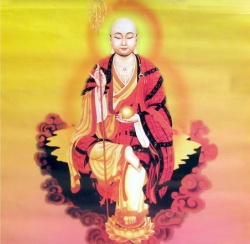A Short Course of Chan Practice
1. Preparation
a. You will need 2 rooms or one separated by a curtain in which there should be a small hole for the helper to see whether the practitioner is all right but not for the practitioner to see the helper.
b. The practitioner's room should be larger than the helper's room. A round table should be placed in the center. There should be nothing else except a bed which may be used as a chair. Books, newspapers, and everything else should be avoided. (Of course, some light is needed).
c. Whatever food the practitioner would like to have he may eat in two or three meals daily which will be brought in by the helper at fixed times. Nothing should be taken in between.
d. It is better if the first time of practice is limited to five days or at most a week. Afterwards the duration may be increased to a fortnight or one month or one hundred days, or even twelve years.
e. The date should be chosen according to astrology. The time for entering the room of practice is afternoon. The time for completing the course is the morning.
f. Before entering one should worship the Guru, the God Protector of the place where the room is situated in and ask for their help to be successful in Chan and for pardon if the practitioner has not thought of any God or spirit or ghost or deity of the land where the practitioner lives during the time the practice is going on.
2. Main Practice, or Hua-Tou
a. Where is the mind?
b. Before I was born in this world, where was I?
c. Where does this idea or conception or delusion or thinking come from?
d. Any Hua-Tou found in my book "The Lighthouse in the Ocean of Chan" or any other book may be used. The rule for choosing lies in the force of the feeling of doubt it arouses. That Hua-Tou which gives rise to the strongest feeling of doubt is the best one for you.
When a Hua-Tou is chosen it should be kept throughout the whole course of practice. From the time of getting up to the time of going to sleep, one should keep the Hua-Tou continuously without break. Concentrated thoughts on the Hua-Tou should follow one another like arrows shot up in the sky; if one by one they do not touch or come close to the preceding one, all the arrows will fall down. Therefore, one by one, they should be tightly close to one another so as not to allow any other idea to come in-between. This is the very secret of the method.
However, thoughts unrelated to the Hua-Tou might come very often. You should not follow them but return to the Hua-Tou. By and by the intruding thoughts might decrease. For this practice no special posture is needed. You may walk, sit, lie down as you like.
3. Running and Shock
Take the table as the center around which you start walking clockwise, slowly at first then gradually increasing the speed until you run quickly. The body should slant a little to the inner side, towards the table. The left arm should move more than the right arm. These two actions enable the left nerve to stretch entirely so that the air goes downward and thoughts will decrease. All this time the Hua-Tou should be kept tightly.
As you are thus running the helper should watch you through the hole and when he sees that you are running quickly, he must with force strike the table in his own room once¾ not more than once¾ with a wooden hammer. The sound will startle you. At this moment the Chan might appear and the Hua-Tou will be lost into the Chan.
When you hear the sound, you must immediately stand still and should not run again.
The above practice (Running and Shock) should be done only on an empty stomach before a meal and twice a day is enough.
